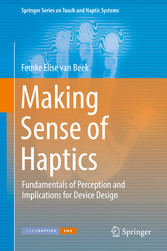Suche
Lesesoftware
Specials
Info / Kontakt
Making Sense of Haptics - Fundamentals of Perception and Implications for Device Design
von: Femke Elise van Beek
Springer-Verlag, 2018
ISBN: 9783319699202 , 157 Seiten
Format: PDF, Online Lesen
Kopierschutz: Wasserzeichen




Preis: 96,29 EUR
eBook anfordern 
Mehr zum Inhalt

Making Sense of Haptics - Fundamentals of Perception and Implications for Device Design
Acknowledgements
7
Contents
8
1 Introduction
12
1.1 Teleoperation
13
1.2 Haptic Perception
14
1.3 Psychophysics
14
1.4 Outline
17
References
19
Part I Static Perception
21
2 Perception of Force Direction and Magnitude
22
2.1 Introduction
23
2.2 Materials and Methods
25
2.2.1 Subjects
25
2.2.2 Setup
25
2.2.3 Experimental Procedure
27
2.2.4 Data Analysis
28
2.2.5 Statistics
29
2.3 Results
30
2.3.1 Force Magnitude
30
2.3.2 Force Direction
30
2.4 Discussion
32
2.4.1 Force Magnitude
33
2.4.2 Force Direction
37
2.5 Conclusion
37
References
38
3 Perception of Force Direction
40
3.1 Introduction
40
3.2 Material and Methods
42
3.2.1 Subjects
42
3.2.2 Set-Up
42
3.2.3 Protocol
43
3.2.4 Statistics
43
3.3 Results
44
3.4 Discussion and Conclusion
45
References
46
4 Perception of Force Magnitude and Postural Arm Dynamics
48
4.1 Introduction
48
4.2 Methods
51
4.2.1 Participants
51
4.2.2 Setup
51
4.2.3 Procedure
53
4.2.3.1 Experiment 1: Perception
53
4.2.3.2 Experiment 2: Arm Dynamics
53
4.2.4 Position Disturbance Signal Design
54
4.2.5 Data Analysis
55
4.2.5.1 Perceptual Data
55
4.2.5.2 Arm Dynamics Data
56
4.2.5.3 Impedance Model Fit
57
4.2.5.4 Statistics
58
4.3 Results
59
4.3.1 Experiment 1: Perception
59
4.3.2 Experiment 2: Arm Dynamics
60
4.4 Discussion
61
References
66
Part II Dynamic Perception
69
5 Discrimination of Distance
70
5.1 Introduction
70
5.1.1 Reference Distance
71
5.1.2 Movement Axis
72
5.1.3 Movement Mode
72
5.1.4 Stimulus Type
73
5.2 Materials and Methods
73
5.2.1 Participants
73
5.2.2 Conditions
74
5.2.3 Setup
74
5.2.4 Procedure
76
5.2.5 Data Analysis
77
5.3 Results
79
5.4 Discussion
82
5.4.1 Reference Distance
82
5.4.2 Movement Axis
83
5.4.3 Movement Mode
83
5.4.4 Stimulus Type
84
5.4.5 Movement Strategy
84
5.4.6 Conclusion
85
References
86
6 The Effect of Damping on the Perception of Hardness
88
6.1 Introduction
89
6.2 Material and Methods
91
6.2.1 Participants
91
6.2.2 Protocol
91
6.2.2.1 General
91
6.2.2.2 Experiment 1
94
6.2.2.3 Experiment 2
95
6.2.2.4 Experiment 3
95
6.2.3 Data Analysis
95
6.2.3.1 Perceptual Data
95
6.2.3.2 Position and Force Data
96
6.3 Results
98
6.3.1 Experiment 1
98
6.3.1.1 Perceptual Data
98
6.3.1.2 Position and Force Data
100
6.3.2 Experiment 2
101
6.3.2.1 Perceptual Data
101
6.3.2.2 Position and Force Data
101
6.3.3 Equal Hardness Lines
101
6.3.4 Experiment 3
103
6.3.4.1 Perceptual Data
103
6.3.4.2 Position and Force Data
104
6.4 Discussion
105
6.5 Conclusion
107
References
107
Part III Applications
109
7 Integrating Force and Position
110
7.1 Introduction
111
7.2 Models
112
7.2.1 Bisection Model
113
7.2.2 Stiffness Model
116
7.3 Material and Methods
118
7.3.1 Participants
118
7.3.2 Setup
119
7.3.3 Protocol
120
7.3.4 Device Performance
122
7.3.5 Data Analysis
123
7.4 Results
125
7.4.1 Measured and Expected Biases
125
7.4.2 Experiment 1
125
7.4.3 Experiment 2
127
7.4.4 Model Fits
128
7.5 Discussion
128
7.6 Conclusion
131
References
131
8 Visuo-Haptic Biases in Haptic Guidance
133
8.1 Introduction
133
8.2 Materials and Methods
136
8.2.1 Participants
136
8.2.2 Apparatus
136
8.2.3 Protocol
138
8.2.4 Data Analysis
141
8.3 Results
142
8.4 Discussion
144
8.5 Conclusions
146
References
146
9 General Discussion
148
9.1 Fundamental Insights
148
9.1.1 Part I: Static Perception
149
9.1.2 Part II: Dynamic Perception
149
9.1.3 Part III: Applications
150
9.2 Reproducibility
151
9.3 Implications for Design
153
9.3.1 Haptic Parameters for Haptic Device Design
153
9.3.2 Haptic Parameters for Haptic Guidance Design
154
References
156






